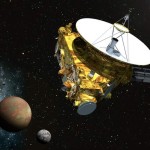Pluto map
 NASA releases this map compiled from photos taken between June 27 and July 3 showing the following features along the equator: The long dark area on the left, named “the whale” measures 3,000 km (1,800 miles), above the whale’s tail is a doughnut shaped area measuring 350km (200 miles) across, to the right of the whale’s head is the brightest region, and further to the right are four mysterious dark spots.
NASA releases this map compiled from photos taken between June 27 and July 3 showing the following features along the equator: The long dark area on the left, named “the whale” measures 3,000 km (1,800 miles), above the whale’s tail is a doughnut shaped area measuring 350km (200 miles) across, to the right of the whale’s head is the brightest region, and further to the right are four mysterious dark spots.
Discovers heart-shaped region
The probe discovers a heart-shaped region on Pluto:
https://twitter.com/NewHorizons2015/status/619081578602479616
Over the next week the spacecraft will be just 7,750 miles away from the dwarf planet. Team member:
The next time we see this part of Pluto at closest approach, a portion of this region will be imaged at about 500 times better resolution than we see today. It will be incredible.
First signs of Pluto’s geological features
 New Horizons takes this photo 5.4 million km (3.3 million miles) from Pluto which starts to show distinct geological features on the surface.
New Horizons takes this photo 5.4 million km (3.3 million miles) from Pluto which starts to show distinct geological features on the surface.
We’re close enough now that we’re just starting to see Pluto’s geology. Among the structures tentatively identified in this new image are what appear to be polygonal features; a complex band of terrain stretching east-northeast across the planet, approximately 1,000 miles long; and a complex region where bright terrains meet the dark terrains of the whale.
Pluto, Charon portrait
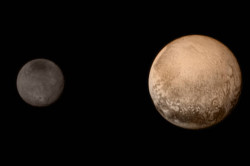 The team puts together a photo from New Horizons LORRI and RALPH showing a portrait of Pluto and Charon as the probe makes its final approach.
The team puts together a photo from New Horizons LORRI and RALPH showing a portrait of Pluto and Charon as the probe makes its final approach.
Pluto far side
 At 4 million km (2.5 million miles), New Horizons takes this photo of Pluto’s far side showing four dark mysterious spots about 480 km (300 miles) across. The spots are connected to a dark belt that circles Pluto’s equatorial region. What continues to pique the interest of scientists is their similar size and even spacing.
At 4 million km (2.5 million miles), New Horizons takes this photo of Pluto’s far side showing four dark mysterious spots about 480 km (300 miles) across. The spots are connected to a dark belt that circles Pluto’s equatorial region. What continues to pique the interest of scientists is their similar size and even spacing.
It’s weird that they’re spaced so regularly. We can’t tell whether they’re plateaus or plains, or whether they’re brightness variations on a completely smooth surface.
This will be the best picture of Pluto’s far side, which always faces Charon, as the probe will be on the other side as it passes by Pluto.
Charon close up
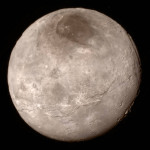 New Horizons takes a photo of Charon from 466,000 km (289,000 miles) away. A series of cliffs and valleys stretch about 1,000 km (600 miles) from left to right, suggesting widespread fracturing of Charon’s crust. At upper right is a canyon about 7-9 km (4-6 miles) deep. The north polar region reveals a dark spot suggesting a thin deposit of material. The lack of craters suggests that the surface is still young being reshaped by geologic activity.
New Horizons takes a photo of Charon from 466,000 km (289,000 miles) away. A series of cliffs and valleys stretch about 1,000 km (600 miles) from left to right, suggesting widespread fracturing of Charon’s crust. At upper right is a canyon about 7-9 km (4-6 miles) deep. The north polar region reveals a dark spot suggesting a thin deposit of material. The lack of craters suggests that the surface is still young being reshaped by geologic activity.
Pluto’s size measured
NASA’s New Horizon mission scientists determine Pluto’s size to be 2,370 kilometers (1,473 miles) in diameter making it the largest known body beyond Neptune.
The size of Pluto has been debated since its discovery in 1930. We are excited to finally lay this question to rest.
They also determine Charon’s size to be 1208 km (751 miles) in diameter, Hydra is about at 45 km (30 miles) and Nix is about 35 km (20 miles).
Heart shape closeup
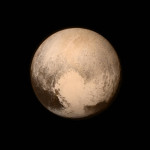 New Horizons takes a photo of Pluto from 768,000 km (476,000 miles) away showing a close-up view of the heart-shaped feature. The heart measures about 1,600 km (1,000 miles) across. The heart borders darker equatorial terrains, and the mottled terrain to its east (right) are complex. However, even at this resolution, much of the heart’s interior appears remarkably featureless—possibly a sign of ongoing geologic processes.
New Horizons takes a photo of Pluto from 768,000 km (476,000 miles) away showing a close-up view of the heart-shaped feature. The heart measures about 1,600 km (1,000 miles) across. The heart borders darker equatorial terrains, and the mottled terrain to its east (right) are complex. However, even at this resolution, much of the heart’s interior appears remarkably featureless—possibly a sign of ongoing geologic processes.
Wow! My prediction was that we would find something wonderful, and we did. This is proof that good things really do come in small packages.
Closest approach
After flying three billion miles from Earth, at 7:49 a.m. EDT, New Horizons makes its closest approach to Pluto at 7,700 miles from the surface. It flies past at 31,000 mph. The team receives confirmation from the spacecraft around 9:00 p.m. EDT that the flyby is a success.
Hey, people of the world! Are you paying attention? We have reached Pluto. We are exploring the hinterlands of the solar system. Rejoice!
Color photos
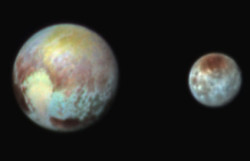 NASA releases color images of Pluto and Charon. The heart shape on Pluto is different colors indicating different geologic, tectonic, or morphological origins. The big red spot near Charon’s north polar region are most likely nitrogen particles from Pluto. The sun burns off the particles on the areas facing the sun, but not the polar region which faces away from the sun for decades.
NASA releases color images of Pluto and Charon. The heart shape on Pluto is different colors indicating different geologic, tectonic, or morphological origins. The big red spot near Charon’s north polar region are most likely nitrogen particles from Pluto. The sun burns off the particles on the areas facing the sun, but not the polar region which faces away from the sun for decades.
Some regions are relatively ancient, and other places are very young and currently undergoing geologic evolution.
Discovers ice mountains
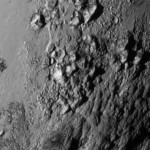 Scientists share the first high-resolution images of Pluto’s surface taken by New Horizons, showing ice mountains 11,000 ft high. Pluto’s thin coating of methane, carbon monoxide and nitrogen ice on Pluto’s surface was not strong enough to form mountains — the scientist believe they are probably composed of Pluto’s water-ice bedrock
Scientists share the first high-resolution images of Pluto’s surface taken by New Horizons, showing ice mountains 11,000 ft high. Pluto’s thin coating of methane, carbon monoxide and nitrogen ice on Pluto’s surface was not strong enough to form mountains — the scientist believe they are probably composed of Pluto’s water-ice bedrock
Mission scientists say the image show a terrain that had been resurfaced by some geological process – such as volcanism – within the last 100 million years.
We have not found a single impact crater on this image. This means it must be a very young surface.
This active geology needs some source of heat. Previously, such activity has only been seen on icy moons, where it can be explained by “tidal heating” caused by gravitational interactions with a large host planet.
You do not need tidal heating to power geological activity on icy worlds. That’s a really important discovery we just made this morning.
Heart-shaped area named after Tombaugh
Scientists name Pluto’s newly-discovered heart-shaped region Tombaugh Regio, after Tombaugh, who discovered the planet in 1930.
Different ices
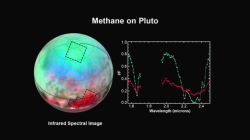 The New Horizons team release a composite photo showing different methane ice accumulations over Pluto’s surface. The photo is compiled using RALPH’s 256 infrared wavelengths overlaying a LORRI basemap.
The New Horizons team release a composite photo showing different methane ice accumulations over Pluto’s surface. The photo is compiled using RALPH’s 256 infrared wavelengths overlaying a LORRI basemap.
All I’m showing is the diversity of terrains. The ices do have distinct properties, different melting points.
Charon mountain
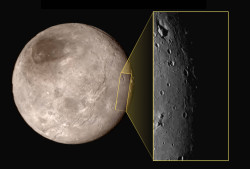 NASA shares a close-up photo of Pluto’s moon Charon showing a large mountain in a deep depression that is puzzling scientists.
NASA shares a close-up photo of Pluto’s moon Charon showing a large mountain in a deep depression that is puzzling scientists.
The most intriguing feature is a large mountain sitting in a moat. This is a feature that has geologists stunned and stumped. It looks like someone just dropped a giant boulder on Charon.
Flyover animation
NASA releases a flyover animation over part of Tombaugh Regio, the heart-shaped area of Pluto, and the Norgay Montes mountains, which are named for Tenzing Norgay, the sherpa who accompanied Edmund Hillary on the first successful ascent of Mt. Everest. The animation is created from images taken by the Long Range Reconnaissance Imager (LORRI) on the New Horizons probe during the Pluto flyby on July 14, 2015. Using photographs taken from just 77,000 kilometers (48,000 miles) away from the surface, the resolution is good enough that features as small as a kilometers across (0.5 miles) are visible.
Frozen plains
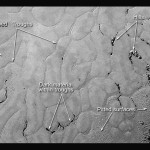 NASA releases a close-up photo of an area in the center-left of the heart feature of a young craterless plain which they name Sputnik Planum. It has a broken surface of irregularly-shaped segments, roughly 20 km (12 miles) across, bordered by what appear to be shallow troughs, some of which have darker material within them, while others are traced by clumps of hills that appear to rise above the surrounding terrain. Elsewhere, the surface appears to be etched by fields of small pits that may have formed by sublimation.
NASA releases a close-up photo of an area in the center-left of the heart feature of a young craterless plain which they name Sputnik Planum. It has a broken surface of irregularly-shaped segments, roughly 20 km (12 miles) across, bordered by what appear to be shallow troughs, some of which have darker material within them, while others are traced by clumps of hills that appear to rise above the surrounding terrain. Elsewhere, the surface appears to be etched by fields of small pits that may have formed by sublimation.
This terrain is not easy to explain. The discovery of vast, craterless, very young plains on Pluto exceeds all pre-flyby expectations.
Nix and Hydra
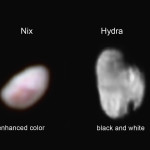 NASA releases photos of Pluto’s moons Nix and Hydra. Nix is about 42 km (26 miles) long and 36 km (22 miles) wide. Nix’s surface is a light gray with an area that is light red which scientists think might be a crater. Hydra is about 55 km (34 miles) long and 40 km (25 miles) wide and has at least two large craters.
NASA releases photos of Pluto’s moons Nix and Hydra. Nix is about 42 km (26 miles) long and 36 km (22 miles) wide. Nix’s surface is a light gray with an area that is light red which scientists think might be a crater. Hydra is about 55 km (34 miles) long and 40 km (25 miles) wide and has at least two large craters.
Before last week, Hydra was just a faint point of light, so it’s a surreal experience to see it become an actual place, as we see its shape and spot recognizable features on its surface for the first time.
Discovers second mountain range
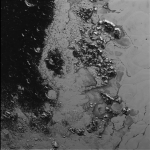 NASA releases a photo showing another mountain range on the lower left edge of Pluto’s heart-shaped region. The peaks are about 1 to 1.5 km (0.5 to 1 mile) high, about the size of the Appalachians. The new range is just west of the region within Pluto’s heart called Sputnik Planum (Sputnik Plain) and some 110 km (68 miles) northwest of Norgay Montes. This newest image further illustrates the remarkably well-defined topography along the western edge of Tombaugh Regio.
NASA releases a photo showing another mountain range on the lower left edge of Pluto’s heart-shaped region. The peaks are about 1 to 1.5 km (0.5 to 1 mile) high, about the size of the Appalachians. The new range is just west of the region within Pluto’s heart called Sputnik Planum (Sputnik Plain) and some 110 km (68 miles) northwest of Norgay Montes. This newest image further illustrates the remarkably well-defined topography along the western edge of Tombaugh Regio.
There is a pronounced difference in texture between the younger, frozen plains to the east and the dark, heavily-cratered terrain to the west. There’s a complex interaction going on between the bright and the dark materials that we’re still trying to understand.
Pluto and Charon’s natural color
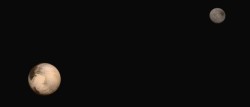 NASA releases this photo which shows Pluto’s reddish color and Charon’s gray tone. Scientists think Pluto’s red color is the result of particles created in its atmosphere, through methane’s interaction with UV light. The particles stick together, growing heavier, and eventually rain down on the surface. Observations show that Charon does not have much of an atmosphere.
NASA releases this photo which shows Pluto’s reddish color and Charon’s gray tone. Scientists think Pluto’s red color is the result of particles created in its atmosphere, through methane’s interaction with UV light. The particles stick together, growing heavier, and eventually rain down on the surface. Observations show that Charon does not have much of an atmosphere.
For now, all that we can say is, it’s a much more rarefied atmosphere [than Pluto’s]. It may be that there’s a thin nitrogen layer in the atmosphere, or methane, or some other constituent. But it must be very tenuous compared to Pluto — again, emphasizing just how different these two objects are despite their close association in space.
Eclipses the sun
 NASA releases a photo of Pluto eclipsing the sun showing a haze in Pluto’s atmosphere which extends at least 160 km (100 miles) above the surface.
NASA releases a photo of Pluto eclipsing the sun showing a haze in Pluto’s atmosphere which extends at least 160 km (100 miles) above the surface.
This is one of our first images of Pluto’s atmosphere. [It] stunned the encounter team. For 25 years, we’ve known that Pluto has an atmosphere. But it’s been known by numbers. This is our first picture. This is the first time we’ve really seen it. This was the image that almost brought tears to the eyes of the atmospheric scientists on our team.
